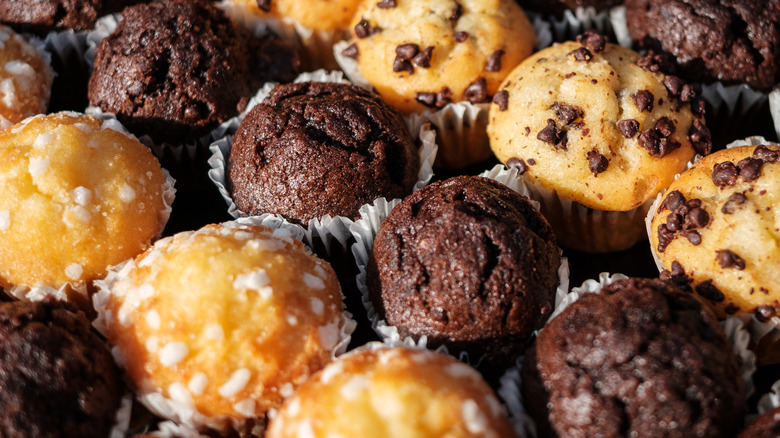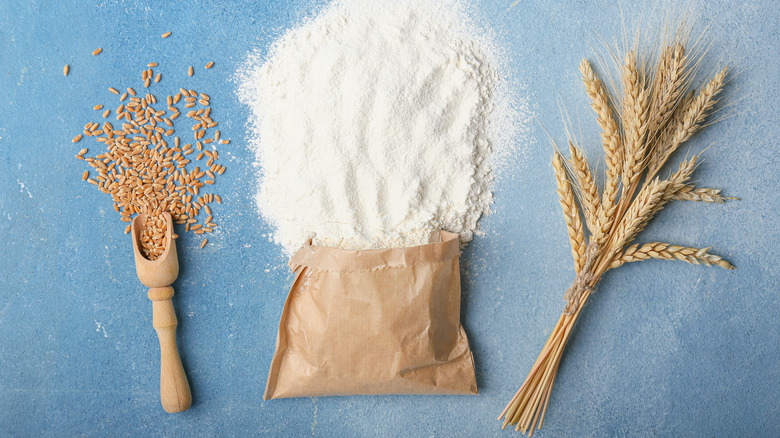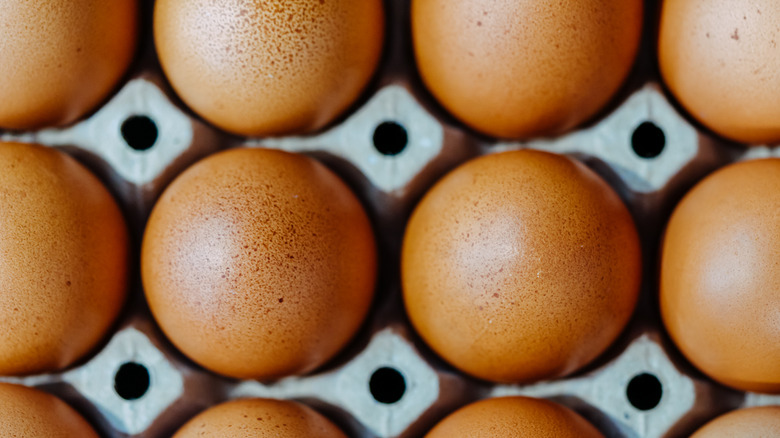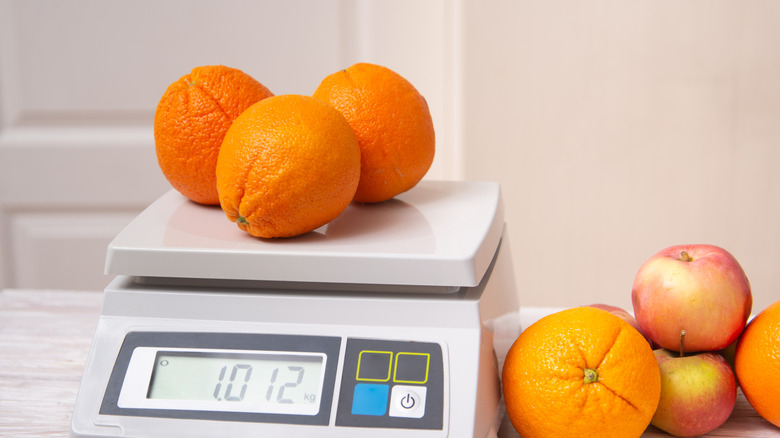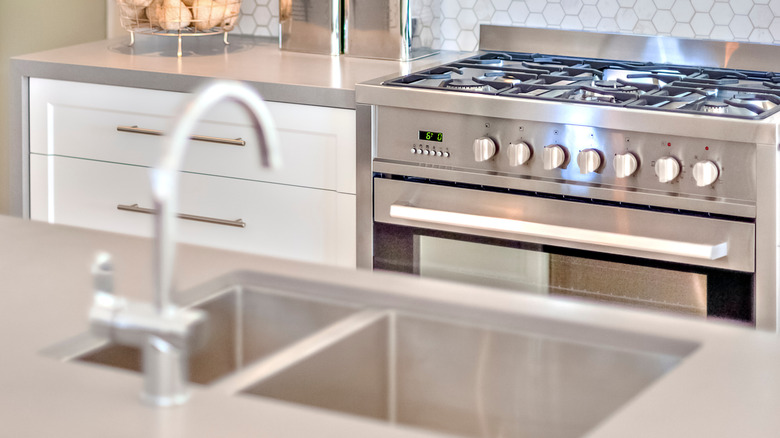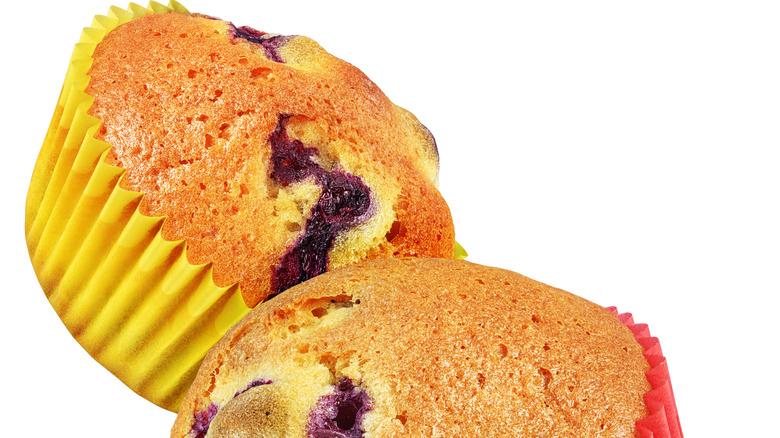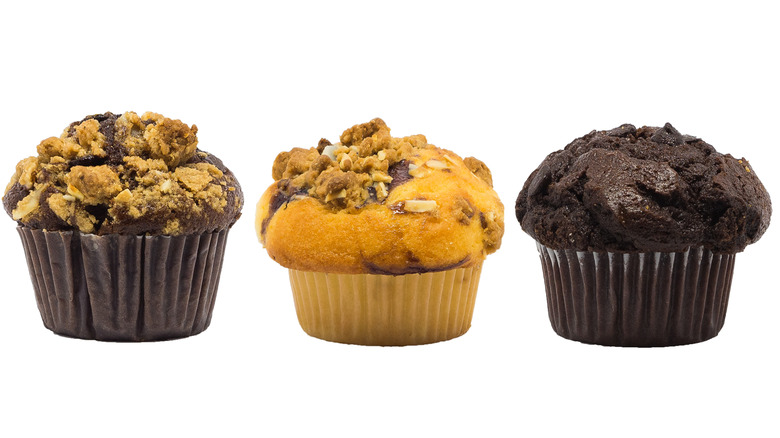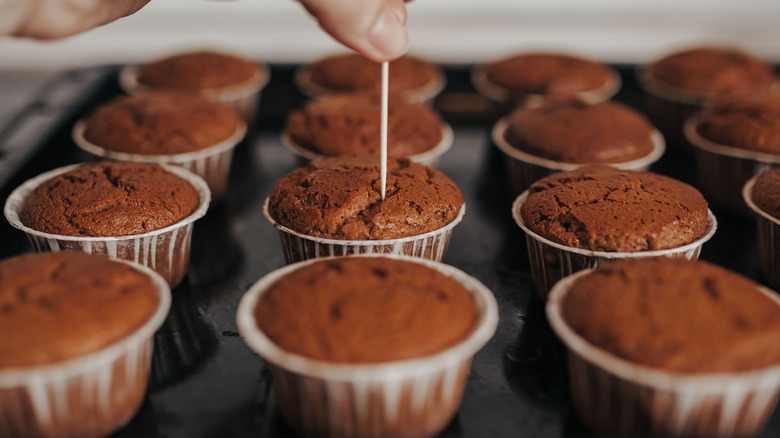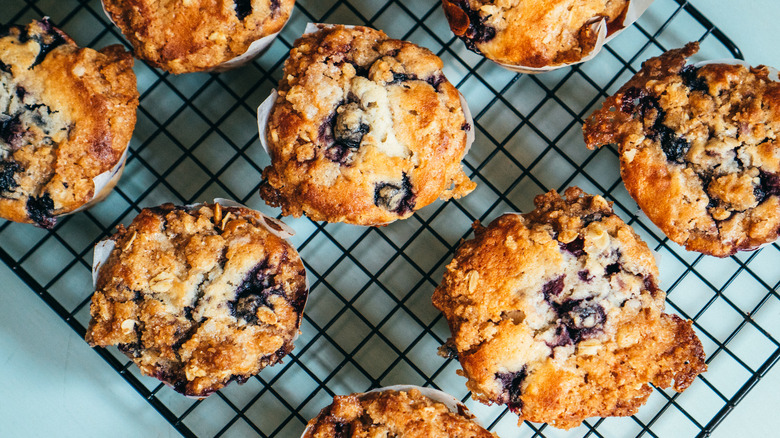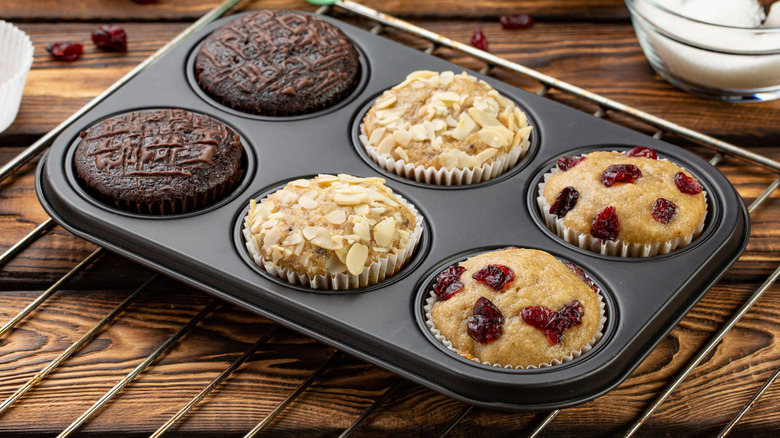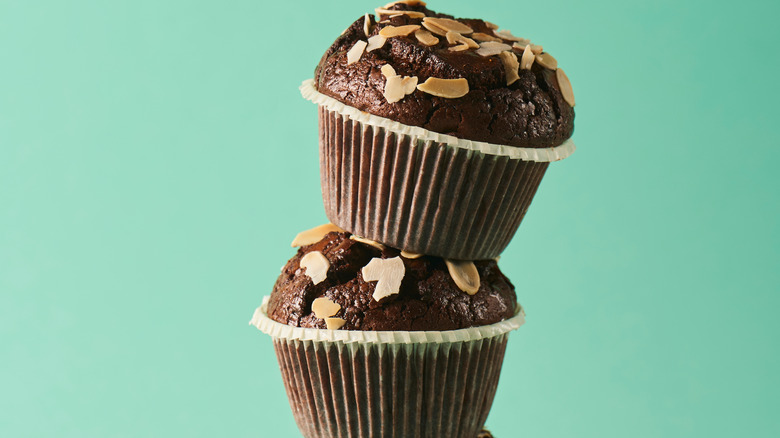The Biggest Mistakes You Make When Baking Muffins
We may receive a commission on purchases made from links.
It's been said that carbs are the ultimate comfort food. And who doesn't need the food equivalent of a warm hug? Sure, bread has been soaking up the limelight lately, with newly minted bakers and old pros alike kneading dough, nurturing starters, trading recipes, and turning out enviable loaves in their own kitchens. But what if you don't want to invest countless hours to see delicious results? What if you need more immediate carb satisfaction, a tasty bite that can be mixed and baked in a jiffy, rather than a multi-hour project?. Enter the muffin.
As cute as a cupcake, lighter than a scone, muffins are usually eaten for breakfast or an afternoon snack. They're also a cinch to make. They can be as fancy as a streusel-topped muffin, or as basic as a corn muffin, a cousin of cornbread.
If by now you're hurrying into your kitchen, posthaste, scrounging around for that set of measuring cups and setting up your mise en place, hold on to your apron for a second. As with every baking endeavor, having a few tricks of the trade in your culinary arsenal can make the difference between mediocre results and full-on success. If you ask us, here are some of the biggest mistakes you make when baking muffins.
Using expired baking ingredients for your muffins
There are no shortcuts when it comes to the ingredients you use when baking muffins, and that includes using ingredients that have been hanging out at the back of your pantry for far too long. Using fresh, quality baking ingredients help ensure that your muffins — and every baking project you undertake — wind up tasting heavenly. As the Food Network reminds us, baking is all about chemistry, so if you want your culinary creations to come out moist yet dense (or chewy, light, or flaky, depending on what you're baking) you're going to have to break out the good stuff.
Basics like baking powder and baking soda, as well as yeast, are leavening agents, and help create a light texture or crumb. That means if you want your muffins to rise and have the perfect texture, you can't use expired leaveners that may have lost their magic.
And the same goes for every other ingredient your favorite muffin recipe calls for. If you've been hanging on to that bag of flour since your last holiday party two years ago, or your butter or oil expired last month, now is the time to replace them. Many flours can be stored unopened for six months to a year, in the pantry or refrigerator, while granulated sugar can last for years. Still, it's best to check the expiration dates before you get started.
Skipping the room temperature step when making muffins
And while we're on the topic of baking fundamentals, here's a friendly reminder that it's also a huge no-no to use refrigerator-cold butter, eggs, liquids, and other ingredients in your creation — unless, of course, the recipe you're working from calls specifically for cold ingredients. Before you start mixing your batter together, make sure that your baking ingredients come to room temperature, which is about 70 degrees.
According to Epicurious, it all comes down to science. Creating the right structure in your batch of muffins (or any baking undertaking, for that matter) is directly related to how warm or cold your ingredients are. Butter that's a little warm and soft, for example, is able to better mix with the sugar and create a more creamy batter. So taking your ingredients out of the refrigerator a few hours before prep time is just as important as precisely measuring (or weighing) your ingredients. Similarly, cold eggs or milk hitting a warm batter can cause the mixture to curdle — not a reaction you're looking for when you're trying to create a sweet treat.
Measuring muffin ingredients instead of weighing ingredients
While muffin making doesn't require expensive kitchen tools — a set of mixing bowls, a wooden spoon, a spatula, measuring spoons, a nonstick muffin tin, and perhaps a whisk, are all you probably need — you might want to shell out another $40 or $50 for a digital kitchen scale. It may seem like a frivolous purchase, but it's a tool that, when used properly, can improve all of your baking projects.
Some culinary pros believe that weighing your ingredients on a kitchen scale, as opposed to measuring your ingredients (which is probably how many of us were taught) is an essential trick of the trade. "Weighing ingredients is finally getting some respect in the States," Anne Margaret O'Hare, chef/owner of the NYC-based catering company, O Cuisine Catering, told Mashed. Kitchen scales, she explains, have long been a standard tool for chefs in Europe. "Weighing ingredients, not measuring or scooping, is more accurate, because the way one person or another might measure, can fluctuate. You can even put liquids on the scale."
Not preheating the oven when you make muffins
While skipping the preheat-the-oven step might seem like a smart time-saver, believe us, it's not worth those extra 15 or 20 minutes. A preheated oven is necessary if you want consistent, perfectly cooked muffins. And that's definitely what we want. Remember those leavening agents, our cooking pals baking soda and baking powder? It's particularly essential to preheat an oven whenever you use one or both, because they react to the rapid change in temperature — so being in the oven while it slowly heats just won't get the same result.
But preheating shouldn't end after 15 minutes. "When you preheat the oven to say 350 degrees, let it heat for 10 minutes more before putting your muffins in, because there are still cool spots in the oven," says Robert Seixas, Director of Culinary Education for Allie's Place Center for Culinary Education & Employment, Homes for the Homeless, in New York City.
Another tip from the pros? "You should use an oven thermometer because oftentimes with home ovens, the temperature is off," says Seixas.
And refrain from opening the oven door to peek inside (no how matter how much you want to!), because you let the heat escape.
Over-mixing your muffin batter
"Advice on muffins? It's like pancakes, don't over-mix it," says Ann Kirk, pastry chef at the restaurants Little Dom's and The 101 Coffee Shop, both in Los Angeles.
In an effort to make sure that all of the ingredients blend together, some novice bakers can get carried away and mix their batter for way too long, until gluten develops in the flour, and the batter becomes smooth. The end result could be a tough (not tender) muffin with air pockets called tunnels. And nobody wants to eat that.
The ideal way to mix is to implement what's known as the muffin method, which is perfect for making quick breads like banana bread, or, of course, muffins. Basically, dry ingredients should be combined in one bowl, wet ingredients in another, then the wet is added to the dry, and barely stirred together until the flour streaks disappear. It's okay if your batter is lumpy — in fact, you want it to be slightly lumpy.
Chef Anne Margaret O'Hare sometimes sifts her flour before she gets started. "Sifting is a nice step. It lightens the flour up, and it spreads more easily. You can incorporate it more gently."
Using paper or aluminum liners for your muffins
With their pretty colors and unique patterns, paper muffin or cupcake liners can add a touch of whimsy to your fresh-baked batch. Paper and aluminum liners might also make your muffins look more professional and they help to make your baked goods moist.
That said, some bakers aren't partial to paper or aluminum liners, or the other alternative, parchment paper, and they have their reasons. "Never use them," cautions Seixas of Allie's Place Center for Culinary Education & Employment. "They inhibit the browning on the sides of the muffins. And they often get stuck, so they're hard to pull out of the tin."
If you're opting out of liners or parchment paper, make sure to grease your muffin tin, even if you use a non-stick version (which is preferable over aluminum tins if sticking is a concern). The greasing options run the gamut from melted butter or shortening, applied with a pastry brush, to cooking spray, oil, and professional baking grease, which can be found in cake supply stores. Some bakers also like to add a light dusting of flour to the muffin tin wells, which, according to Fine Cooking, creates a sealed, smooth crust on baked goods.
Under-filling muffin tins
Muffins can be made in all shapes and sizes, from mini muffins (something of a sensation in the 1930s, according to editor Darra Goldstein's reference tome, The Oxford Companion to Sugar and Sweets) to veritable door stoppers. But if you're craving a bakery-style muffin with an impressive muffin top — that crispy, irresistible crowning glory — it doesn't happen on its own. The secret to creating muffin tops: Don't skimp on the batter unless you want puny muffins. In his recipe for Over the Top blueberry muffins, Alton Brown, host of the Food Network show Good Eats and cookbook author, uses ¼ cup of batter in each of the muffin tin wells, to obtain that much sought-after muffin top.
And if it's a solo muffin top you're after, sans bottom, bake your batter in a muffin top pan, and indulge in what many consider the best part of any muffin! (For some sweet tooths, muffin tops are the only reason to even eat a muffin!)
After filling the tins, resist the temptation to flatten it with a spoon, because all that will do is crush the air in the batter.
Not turning your muffin pan around halfway through baking
If you want your muffins to be golden brown all over, without burnt edges, open the oven halfway through the suggested baking time, and rotate that muffin tin. Some neophyte bakers might not be aware that ovens can have cold and hot areas. Over time, as you become more accustomed to the quirks of your own kitchen oven, you'll begin to notice which direction it tends toward. According to Cook's Illustrated, even calibrated ovens (ovens that have been adjusted for accuracy) can have hot and cold spots, with temperatures plummeting within as much as a 50-degree range.
If you're baking one or two trays of muffins, make sure they're in the center of the oven. If you're on a baking roll and filling your oven to capacity, stagger your pans and switch pans from one rack to the other, midway through baking. And if you're multitasking or easily distracted, use a timer to remind yourself to rotate that pan. That way you won't end up with a batch that's half burned, and half under-cooked.
Not relying on the toothpick trick
Your muffin recipe may call for a baking time of, say, 30 minutes, in a 375 degree oven, but that may not be the final word. Since by now you know that some ovens can run hot or cold, you may need to tack on an extra few baking minutes in the oven — or pull out the muffin tray a few minutes before call time, to prevent excess browning. This is the moment where you take a clean toothpick and insert it into the center of a muffin. If you want a moist muffin, look for a few crumbs on the toothpick. If it comes out clean, the crumb is probably completely set, with no extra moisture. It all depends on how you like your muffins.
If you've been vigilant with your toothpick, your baked creations won't fall into that dreaded territory of overcooked muffins.
In "How to Bake Everything," cookbook author Mark Bittman suggests that recipe instructions should be followed and measurements should be exact, but notes that a moment may arise when you need to use your best judgement and bake with your senses. In other words, using your intuition, confidence, and experience to decide when your muffins are done. Using your senses, Bittman says, will make you a better baker.
Leaving muffins in the pan to cool
It might seem like a good idea to let your muffins sit in the pan after taking them out of the oven. After all, what harm could it do? Plus, you have a sink full of bowls and spatulas to wash. Except, that's a very bad idea.
Baked goods continue to cook in the residual heat, even after you take them out of the oven. That's definitely not what you want them to do once you've determined they're done baking.
If you leave them to cool in the muffin tray for more than a few minutes, you may also wind up with a soggy batch. According to Foodal, sogginess can result when the moisture is absorbed back into the crumb. When the hot muffins stay in the pan, the released steam hits the tin walls and condenses — what other choice does it have, since there's no other way to release it? Not exactly the reward you were looking for after all of your effort.
To avoid both of those problems, take those muffins out of the baking tray after a few minutes and place them on a rack to cool. Done and done.
Eating your muffins only one way
Muffins are usually wolfed down, um, eaten, cold or hot from the oven for breakfast or an afternoon snack. Some kinds of muffins, like corn muffins and blueberry muffins, also taste delicious when toasted and slathered with butter and jelly, or even cream cheese.
But you can also get very, very creative. It turns out that there are more than a few ways to eat your morning muffin. According to Taste of Home, muffins can be spread with creamy butter and sautéed in a griddle, eaten open-face style with peanut butter, turned into a kind of crumb sandwich (with the muffin cut in half and the crumbs facing inward), or drizzled with a sugary glaze, while stale muffins can get a second life when dipped in eggs and turned into French toast or used as a major ingredient in a tempting bread pudding.
Who knew? Bet you never imagined that when you baked your last batch of muffins!
Restricting your imagination — muffins come in infinite varieties
Whether savory, sweet, or somewhere in between, muffins come in infinite varieties, from corn muffins and blueberry muffins to chocolate chip muffins, banana muffins, and streusel-topped muffins. And your recipe, whether it was passed down through your family for generations or taken from a blog, just may be the starting point for total innovation.
Let's say your recipe calls for vanilla extract, but you only have almond extract, or the ingredients list cinnamon, but your cabinet boasts ... nutmeg. Maybe honey is the sweetener suggested, but you only have agave nectar on hand. In some cases you can consult substitution charts to see what the right replacement might be for what you lack. But if you have a bit of baking experience under your belt, you may want to use this as an opportunity to leap into uncharted territory. You might wind up loving that almond flavor more than you expected.
"Muffins are one of those pastries that you can easily get creative with," says Ann Kirk of Little Dom's. "Try subbing different fruits into your blueberry muffin recipe. It's also a nice touch to add texture by putting Demerara sugar on top. Sprinkle it on just before baking."
